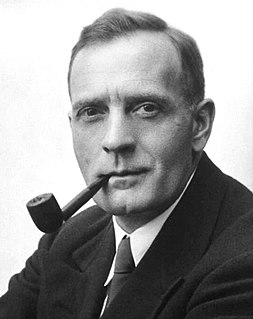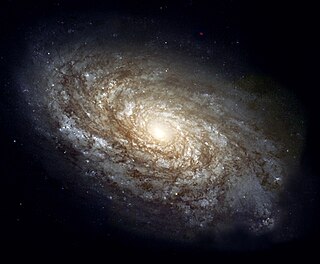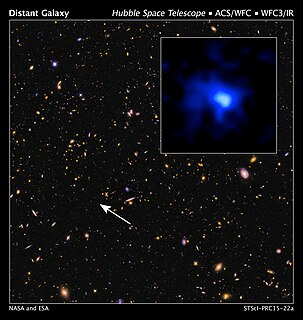Related Research Articles

Edwin Powell Hubble was an American astronomer. He played a crucial role in establishing the fields of extragalactic astronomy and observational cosmology.

A galaxy is a gravitationally bound system of stars, stellar remnants, interstellar gas, dust, and dark matter. The word galaxy is derived from the Greek galaxias (γαλαξίας), literally "milky", a reference to the Milky Way. Galaxies range in size from dwarfs with just a few hundred million stars to giants with one hundred trillion stars, each orbiting its galaxy's center of mass.

Sandra Moore Faber is an astrophysicist known for her research on the evolution of galaxies. She is the University Professor of Astronomy and Astrophysics at the University of California, Santa Cruz, and works at the Lick Observatory. She has made important discoveries linking the brightness of galaxies to the speed of stars within them and was the co-discoverer of the Faber–Jackson relation. Faber was also instrumental in designing the Keck telescopes in Hawaii.

Allan Rex Sandage was an American astronomer. He was Staff Member Emeritus with the Carnegie Observatories in Pasadena, California. He determined the first reasonably accurate values for the Hubble constant and the age of the universe.
Rychard J. Bouwens is an associate professor at the University of Leiden. He is also a former member of the Advanced Camera for Surveys Guaranteed Time Observation team and postdoctoral research astronomer at the University of California, Santa Cruz. He obtained his bachelor's degree in physics, chemistry, and mathematics from Hope College. He then went on to earn his Ph.D. in physics at the University of California, Berkeley under the supervision of Joseph Silk and also worked with Tom Broadhurst.
Amy J. Barger is an American astronomer and Henrietta Leavitt Professor of Astronomy at the University of Wisconsin–Madison. She is considered a pioneer in combining data from multiple telescopes to monitor multiple wavelengths and in discovering distant galaxies and supermassive black holes, which are outside of the visible spectrum. Barger is an active member of the International Astronomical Union.
Sally Oey is an American astronomer at the University of Michigan and an expert in massive, hot stars which are often precursors to supernovae. In 1999, she was awarded the Annie J. Cannon Award in Astronomy by the American Astronomical Society (AAS) and in 2006 was invited to give an address to the 206th meeting of the AAS. Dr. Oey is currently a Professor and is a member of the board of the Gemini Observatory.

Alexei Vladimir "Alex" Filippenko is an American astrophysicist and professor of astronomy at the University of California, Berkeley. Filippenko graduated from Dos Pueblos High School in Goleta, California. He received a Bachelor of Arts in physics from the University of California, Santa Barbara in 1979 and a Ph.D. in astronomy from the California Institute of Technology in 1984, where he was a Hertz Foundation Fellow. He was a postdoctoral Miller Fellow at UC Berkeley and was subsequently appointed to a faculty position at the same institution. He was later named a Miller Research Professor for Spring 1996 and Spring 2005, and he is now a Senior Miller Fellow. His research focuses on supernovae and active galaxies at optical, ultraviolet, and near-infrared wavelengths, as well as on black holes, gamma-ray bursts, and the expansion of the Universe.

Wendy Laurel Freedman is a Canadian-American astronomer, best known for her measurement of the Hubble constant, and as director of the Carnegie Observatories in Pasadena, California, and Las Campanas, Chile. She is now the John & Marion Sullivan University Professor of Astronomy and Astrophysics at The University of Chicago. Her principal research interests are in observational cosmology, focusing on measuring both the current and past expansion rates of the universe, and on characterizing the nature of dark energy.

Christopher David Impey is a British astronomer, educator, and author. He has been a faculty member at the University of Arizona since 1986. Impey has done research on observational cosmology, in particular low surface brightness galaxies, the intergalactic medium, and surveys of active galaxies and quasars. As an educator, he has pioneered the use of instructional technology for teaching science to undergraduate non-science majors. He has written many technical articles and a series of popular science books: Einstein's Monsters The Living Cosmos, How It Ends, How It Began, Dreams of Other Worlds, and Humble Before the Void. He served as Vice-President of the American Astronomical Society, he is a Fellow of the American Association for the Advancement of Science, and a Howard Hughes Medical Institute Professor. Impey also serves on the Advisory Council of METI.

The Cosmic Assembly Near-infrared Deep Extragalactic Legacy Survey (CANDELS) is the largest project in the history of the Hubble Space Telescope, with 902 assigned orbits of observing time. It was carried out between 2010 and 2013 with two cameras on board Hubble – WFC3 and ACS – and aims to explore galactic evolution in the early Universe, and the very first seeds of cosmic structure at less than one billion years after the Big Bang.

Claudia Megan Urry is an American astrophysicist, who has served as the President of the American Astronomical Society, as chair of the Department of Physics at Yale University, and as part of the Hubble Space Telescope faculty. She is currently the Israel Munson Professor of Physics and Astronomy at Yale University and Director of the Yale Center for Astronomy and Astrophysics. Urry is notable not only for her contributions to astronomy and astrophysics, including work on black holes and multiwavelength surveys, but also for her work addressing sexism and gender equity in astronomy, science, and academia more generally.

Debra Meloy Elmegreen is an American astronomer. She was the first woman to graduate from Princeton University with a degree in astrophysics, and she was the first female post-doctoral researcher at the Carnegie Observatories.
Nia Imara is an American astrophysicist, artist, and activist. Imara was involved in work that deals with galactic mass, star formation and detecting exoplanets. Imara was the first African-American woman to earn a PhD in astrophysics at the University of California, Berkeley and was the inaugural postdoctoral fellow in the Future Faculty Leaders program at Harvard University.

Marcia Jean Rieke is an American astronomer. She is a Regents' Professor of Astronomy and associate department head at the University of Arizona. Rieke is the Principal Investigator on the near-infrared camera (NIRCam) for the James Webb Space Telescope (JWST). She has also served as the deputy-Principal Investigator on the Near Infrared Camera and Multi-Object Spectrometer (NICMOS) for the Hubble Space Telescope (HST), and as the co-investigator for the multiband imaging photometer on the Spitzer Space Telescope, where she also acted as an outreach coordinator and a member of the Science Working Group. Rieke was also involved with several infrared ground-based observatories, including the MMT Observatory in Arizona. She was vice chair for Program Prioritization of the Astro2010 Decadal Survey Committee, "New Worlds, New Horizons". Marcia Rieke is considered by many to be one of the "founding mothers" of infrared astronomy, along with Judith Pipher.
Sangeeta Malhotra is an astrophysicist who studies galaxies, their contents, and their effects on the universe around them. The objects she studies range from our own Milky Way galaxy to some of the earliest and most distant known galaxies in the epoch of cosmic dawn.
Jessica K. Werk is an American astronomer and an associate professor in the Department of Astronomy at the University of Washington. Her work includes the study of intergalactic and interstellar media. Werk was a Hubble fellow at the University of California, Santa Cruz from 2013 to 2016, and won the $65,000 Sloan Fellowship in 2018. Her research focuses on the role of gas in the formation and evolution of galaxies and the intergalactic medium, primarily through spectroscopic observations in the optical and ultraviolet.
Jean P. Brodie is a British astrophysicist. She is professor of astronomy and astrophysics at the University of California, Santa Cruz and an astronomer at the Lick Observatory.
Charles Tsun-Chu Liu is an American astronomer and astronomy educator. His research interests include merging and colliding galaxies, active galactic nuclei, and the star formation history of the universe. He is a former director of the William E. Macaulay Honors College and The Verrazano School at the City University of New York’s College of Staten Island. He currently serves as a professor of physics and astronomy at the College of Staten Island, and as President of the Astronomical Society of New York. In 2019, he was named a Fellow of the American Astronomical Society.
Daniela Calzetti is an Italian and American astronomer known for her research on cosmic dust, star formation, and galaxy formation and evolution, and in particular for the Calzetti dust extinction law, an estimate for how much information about distant galaxies has been obscured by cosmic dust. She is a professor of astronomy and head of the astronomy department at the University of Massachusetts Amherst, and principal investigator of the Legacy ExtraGalactic Ultraviolet Survey project of the Hubble Space Telescope.
References
- ↑ Stiles, Lori (19 February 2001), "Astronomer Surveys Galaxy Groups Beyond the Local Galactic Neighborhood", News, University of Arizona, retrieved 2021-03-31
- 1 2 Littin, Shelley (16 October 2012), "Seeking the Earliest Galaxies with Cosmic Telescopes", News, University of Arizona, retrieved 2021-03-31
- ↑ Jenner, Lynn (4 December 2020), "Hubble Gazes Upon Cosmic Wonderland", Solar System and Beyond, NASA, retrieved 2021-03-31
- 1 2 3 4 "Ann Zabludoff", Fellows, Guggenheim Foundation, retrieved 2021-03-31
- 1 2 3 4 "Ann I. Zabludoff", Profiles, University of Arizona, retrieved 2021-03-31